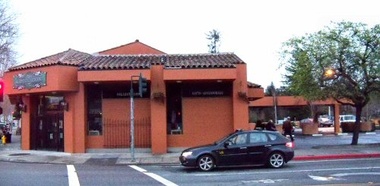Banks were originally built to look impressive. If the building looked impressive it gave the appearance that the bank had lots of money. During the 20th century the appearance became less important.
If a building was designed as a bank, it included a section for a vault. When the building is sold for other use, the vault stays because it is too costly to remove. (The vault door usually goes with the bank. Those things are expensive and can be reused or re-sold.)
Listed here are Santa Cruz County former bank buildings. Buildings that were built as banks and became something else. This list does not include bank buildings that later became a different bank.
Pacific Avenue
1502 Pacific Avenue
According to the plaque on the side of the building... The area suffered a fire in 1894. County Bank of Santa Cruz relocated to this area and had the bank built by 1895. There was extensive remodeling in 1910 and the building was expanded in 1979. In 1977 it was awarded Landmark Status by the Santa Cruz Museum of Art & History. This building was placed on the National Register of Historic Places in 1982. It was added to the Santa Cruz Historic Building Survey in 1989. The building was demolished except for the façade which is preserved. The structure within the walls is entirely new since the 1989 earthquake.
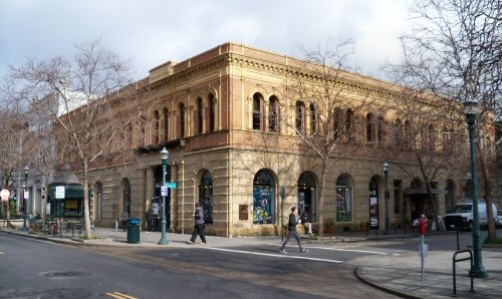 1502 Pacific Avenue. Photo by John Pilge. January 2012. 1502 Pacific Avenue. Photo by John Pilge. January 2012. |
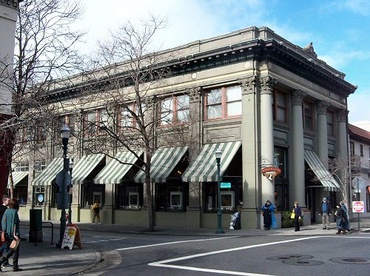 1515 Pacific Avenue. 1515 Pacific Avenue. |
1515 Pacific Avenue
Peoples Bank built in 1910. Notice the name is "PEOPLES" and not "People's" since it is a plural and not possessive. The name can still be seen atop the front of the building. The architect was William Weeks of Watsonville. (Weeks was also know for building churches.) The building is considered Neo-Classical Revival. According to the 1930 and 1931 Santa Cruz Phone Directory, this was the Farmers and Merchants National Bank. It was added to the Santa Cruz Historic Building Survey in 1989. Farmers & Merchants Bank was later acquired by Wells Fargo.
The building was listed as an historic landmark by the Museum of Art and History in 1990.
1134 Pacific Avenue
Built in 1929 as Bank of Italy. (The name changed in 1930 to Bank of America.) It was taken over by New Leaf Market in 1995. You can still see the "Bank of Italy" sign above the entrance on Pacific Avenue. In 1982 the Museum of Art and History offered landmark status to the building. In 1989, this building was added to the Santa Cruz Historic Building Survey.
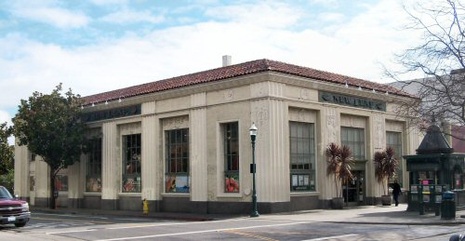 1134 Pacific Avenue. 1134 Pacific Avenue. |
 This 1520 Mission Street building has gone through several changes since it was a bank. This 1520 Mission Street building has gone through several changes since it was a bank. |
Bank of America
1640 Mission St (1960-2019)
806 Ocean.
1134 Pacific Avenue
Mission StreetThe building at 1520 Mission Street was built as a Bell Savings and Loan. It was last used as a bank in 1993 as Western Federal Savings and Loan.
|
.
Soquel Avenue
|
The structure at 1100 Soquel Avenue, was built in 1923 as a bank. The architect was Lee Esty. It is often called the Cayuga Vault building after a business that was once there. Rumor persists that the building was actually built in 1915. It may have been built as a branch of County First National Bank. It is not listed as a bank in the 1930 Santa Cruz phone book. This bank was the Eastside Branch of Bank of America before they built a "new branch" at 1240 Soquel Avenue. There was a similar building at 1024 Soquel Avenue that was a church. This was dedicated in 1923 and was destroyed by fire in 2000. |
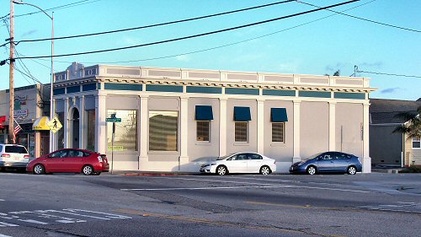 1100 Soquel Avenue, corner of Soquel and Cayuga. It has been a restaurant and later the Cayuga Vault and a meeting facility. 1100 Soquel Avenue, corner of Soquel and Cayuga. It has been a restaurant and later the Cayuga Vault and a meeting facility. |
This building was once used as a campaign headquarters for Bruce McPherson in his successful bid for California Assembly in 1993,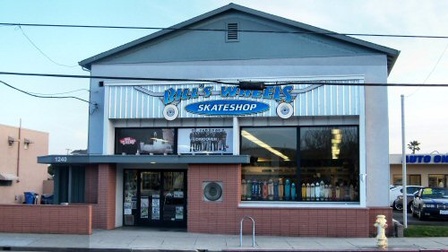 Built as a Bank of America branch. There is still a night deposit hatch on the building. 1240 Soquel Avenue Built as a Bank of America branch. There is still a night deposit hatch on the building. 1240 Soquel Avenue |
|
River Street
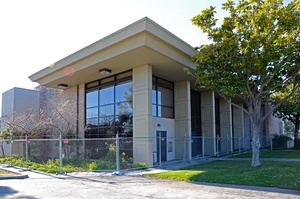 The building at 75 River Street was first built in 1966 as a branch of Salinas Valley Savings and Loan. Later Palo Alto Savings and Loan, then Northern California Savings,merged into Great Western Savings. became Great Western Bank, bought by Washington Mutual, then Bay Bank and later Coast Commercial Bank.
The building at 75 River Street was first built in 1966 as a branch of Salinas Valley Savings and Loan. Later Palo Alto Savings and Loan, then Northern California Savings,merged into Great Western Savings. became Great Western Bank, bought by Washington Mutual, then Bay Bank and later Coast Commercial Bank.
East Cliff Drive
 21511 East Cliff Drive. Open as County Bank of Santa Cruz closed before 1982. 21511 East Cliff Drive. Open as County Bank of Santa Cruz closed before 1982. |
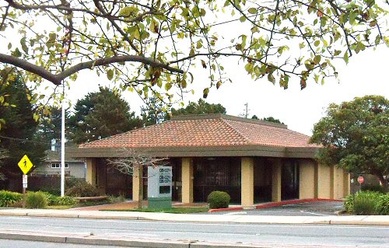 21522 East Cliff Drive. Built as San Diego Federal Savings in 1972. Last banking life was in 1992. 21522 East Cliff Drive. Built as San Diego Federal Savings in 1972. Last banking life was in 1992. |
Portola Drive
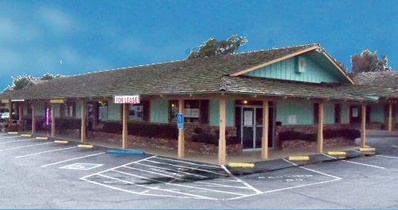 The bank used the entire building at 3701 Portola Drive. It was later the state employment office. The Coffeetopia branch at 3701 Portola Drive, has a room called Bank Vault. It is left over from the time when the building was a County Bank of Santa Cruz. See Coffeetopia bank vault for pictures and details.
The bank used the entire building at 3701 Portola Drive. It was later the state employment office. The Coffeetopia branch at 3701 Portola Drive, has a room called Bank Vault. It is left over from the time when the building was a County Bank of Santa Cruz. See Coffeetopia bank vault for pictures and details.
Soquel DRIVE
 This building at 4630 Soquel Drive was a branch of County Bank of Santa Cruz that closed in the early 1970's. The bank moved the branch to a roomier building in the next block. This was originally the Bank of Soquel before it was acquired by County Bank of Santa Cruz This building at 4630 Soquel Drive was a branch of County Bank of Santa Cruz that closed in the early 1970's. The bank moved the branch to a roomier building in the next block. This was originally the Bank of Soquel before it was acquired by County Bank of Santa Cruz |
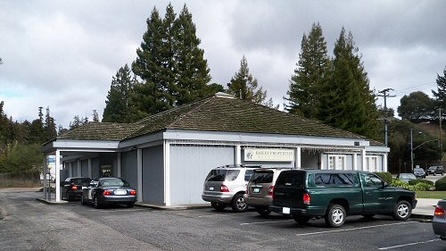 Gavilan Bank had a branch at 9119 Soquel Drive in Aptos. When the bank was acquired by First Interstate Bank the Aptos branch was closed. The drive up window area on this real estate office is used for parking. Gavilan Bank had a branch at 9119 Soquel Drive in Aptos. When the bank was acquired by First Interstate Bank the Aptos branch was closed. The drive up window area on this real estate office is used for parking.
|
World Savings/Wachovia
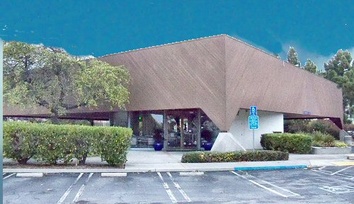 1830 41st Avenue. Built as a World Savings later a Wachovia Bank now a dentist office with a drive up window. (It is still there, but not used by the dentist office.)
1830 41st Avenue. Built as a World Savings later a Wachovia Bank now a dentist office with a drive up window. (It is still there, but not used by the dentist office.)  The Aptos branch at 7970 Soquel Drive is now a real estate office.
The Aptos branch at 7970 Soquel Drive is now a real estate office.
Watsonville
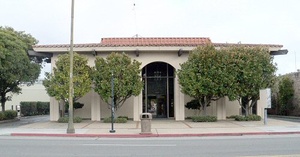 This was once the Watsonville branch of Sumitomo Bank at 558 Main Street. This was once the Watsonville branch of Sumitomo Bank at 558 Main Street. |
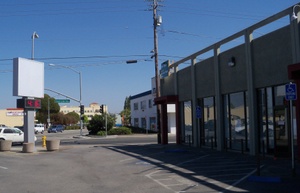 First built as a Watsonville Savings and Loan which became Monterey Bay Bank. The temperature/time was left running after Union Bank moved from East Lake to Main Street in Watsonville in 2013.. First built as a Watsonville Savings and Loan which became Monterey Bay Bank. The temperature/time was left running after Union Bank moved from East Lake to Main Street in Watsonville in 2013.. |
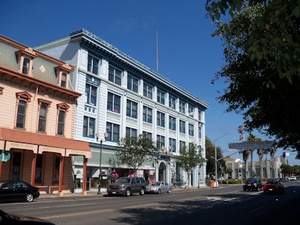 Built in 1914 with Fruit Growers Bank as one of the tenants. The bank later became Liberty National Bank(1925), Bank of Italy(1928), and Bank of America (1930-1969), From 1975 to about 1986 it had a County Bank. The building is at 406 Main St. in Watsonville. Built in 1914 with Fruit Growers Bank as one of the tenants. The bank later became Liberty National Bank(1925), Bank of Italy(1928), and Bank of America (1930-1969), From 1975 to about 1986 it had a County Bank. The building is at 406 Main St. in Watsonville. |
Related Links
- :Departed Businesses Finance
- Banks, Credit Unions and Financial Services
- Bank of America ((Photo of Bank of Italy frame.)
- Peoples Bank

